Pseuduvaria cerina is a species of tree in the Annonaceae family. It is endemic to Peninsular Malaysia. James Sinclair, the Scottish botanist who first formally described the species, named it after its waxy yellow inner petals.

Saurauia clementis is a species of flowering plant in the family Actinidiaceae. It is endemic to the Philippines. Elmer Drew Merrill, the American botanist who first formally described the species, named it after Mary Strong Clemens, the American botanist who collected the specimen that he examined.

Saurauia copelandii is a species of plant in the Actinidiaceae family. It is native to the Philippines. Adolph Daniel Edward Elmer, the American botanist who first formally described the species, named it in honor of Edwin Copeland, another American botanist who collected many botanical samples in the Philippines.
Saurauia glabra is a species of plant in the Actinidiaceae family. It is native to Borneo. Elmer Drew Merrill, the American botanist who first formally described the species, named it after its hairlessness.
Saurauia klemmei is a species of plant in the family Actinidiaceae. It is native to the Philippines. Elmer Drew Merrill, the American botanist who first formally described the species, named it after Wilhelm Klemme, a German forest officer, who collected the specimen Merrill examined from Luzon island in the Philippines.
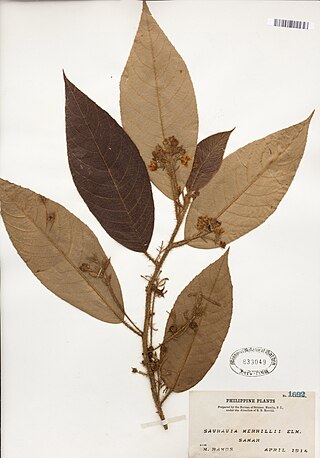
Saurauia merrillii is a species of plant in the family Actinidiaceae. It is native to the Philippines. Adolph Daniel Edward Elmer, the American botanist who first formally described the species, named it in honor of Elmer Drew Merrill, another American botanist.

Saurauia papillulosa is a species of flowering plant in the family Actinidiaceae. It is endemic to the Philippines where it is known as papayang. Elmer Drew Merrill, the American botanist who first formally described the species, named it after the distinctive abundant small bumps, or papillae, on the underside of its leaves.

Saurauia sparsiflora is a species of flowering plant in the family Actinidiaceae. It is endemic to the Philippines. It was discovered on Mount Santo Tomas by Adolph Daniel Edward Elmer, the American botanist who first formally described the species, and named it after the small number, or sparse, flowers in its inflorescences.

Saurauia whitfordii is a species of plant in the Actinidiaceae family. It is native to the Philippines. Elmer Drew Merrill, the American botanist who first formally described the species, named it after Harry Nichols Whitford, another American botanist who collected the specimen Merrill examined.
Goniothalamus puncticulifolius is a species of plant in the family Annonaceae. It is native to Borneo and The Philippines. Elmer Drew Merrill, the American botanist who first formally described the species, named it after its minutely spotted leaves.
Huberantha flava is a species of plant in the family Annonaceae. It is native to The Philippines. Elmer Drew Merrill the American botanist who first formally described the species, using the basionym Polyalthia flava, named it after its brilliant yellow flowers.
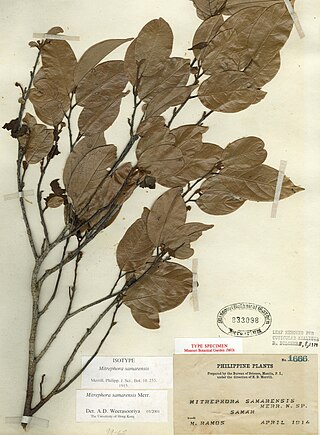
Mitrephora samarensis is a species of plant in the family Annonaceae. It is native to the Philippines. Elmer Drew Merrill, the American botanist who first formally described the species, named it after Samar, the third largest island in the Philippines, where the sample he examined was collected.
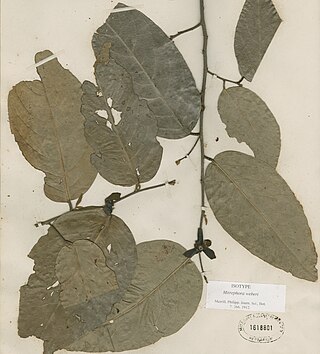
Mitrephora weberi is a species of plant in the family Annonaceae. It is native to The Philippines. Elmer Drew Merrill, an American botanist, first formally described the species and named it after Charles Martin Weber who collected the specimen that Merrill examined.

Pseuduvaria bruneiensis is a species of plant in the family Annonaceae. It is endemic to Borneo. Yvonne Chuan Fang Su and Richard M.K. Saunders, the botanists who first formally described the species, named it after Brunei where the specimens they examined were collected.
Pseuduvaria clemensiae is a species of plant in the family Annonaceae. It is native to New Guinea. Yvonne Chuan Fang Su and Richard M.K. Saunders, the botanists who first formally described the species, named it after Mary Strong Clemens who collected the specimen they examined.
Pseuduvaria coriacea is a species of plant in the family Annonaceae. It is native to New Guinea. Yvonne Chuan Fang Su and Richard M.K. Saunders, the botanists who first formally described the species, named it after its leathery leaves.
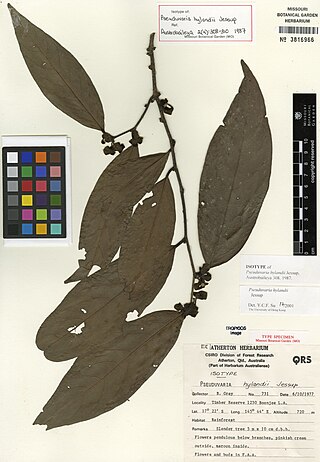
Pseuduvaria hylandii is a species of plant in the family Annonaceae. It is native to Australia. L.W. Jessup, the botanists who first formally described the species, named it after Bernard Hyland an Australian botanist who collected the specimen he examined.

Pseuduvaria multiovulata is a species of plant in the family Annonaceae. It is native to Myanmar. Cecil Fischer, the Indian botanist who first formally described the species using the basionym Mitrephora multiovulata, named it after its many ovuled ovaries.

Pseuduvaria villosa is a species of plant in the family Annonaceae. It is endemic to Australia. L.W. Jessup, the botanist who first formally described the species, named it after its leaves and branchlets which are shaggy with long soft hairs.
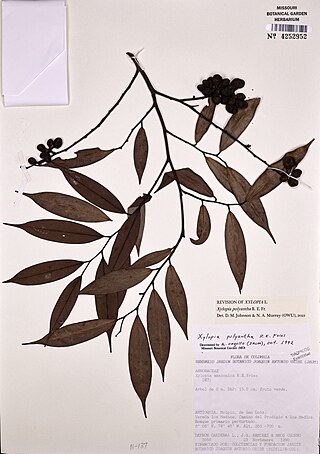
Xylopia polyantha is a species of plant in the Annonaceae family. It is native to Bolivia, Brazil, Colombia, Ecuador, and Peru. Robert Elias Fries, the botanist who first formally described the species, named it after its many flowers.













